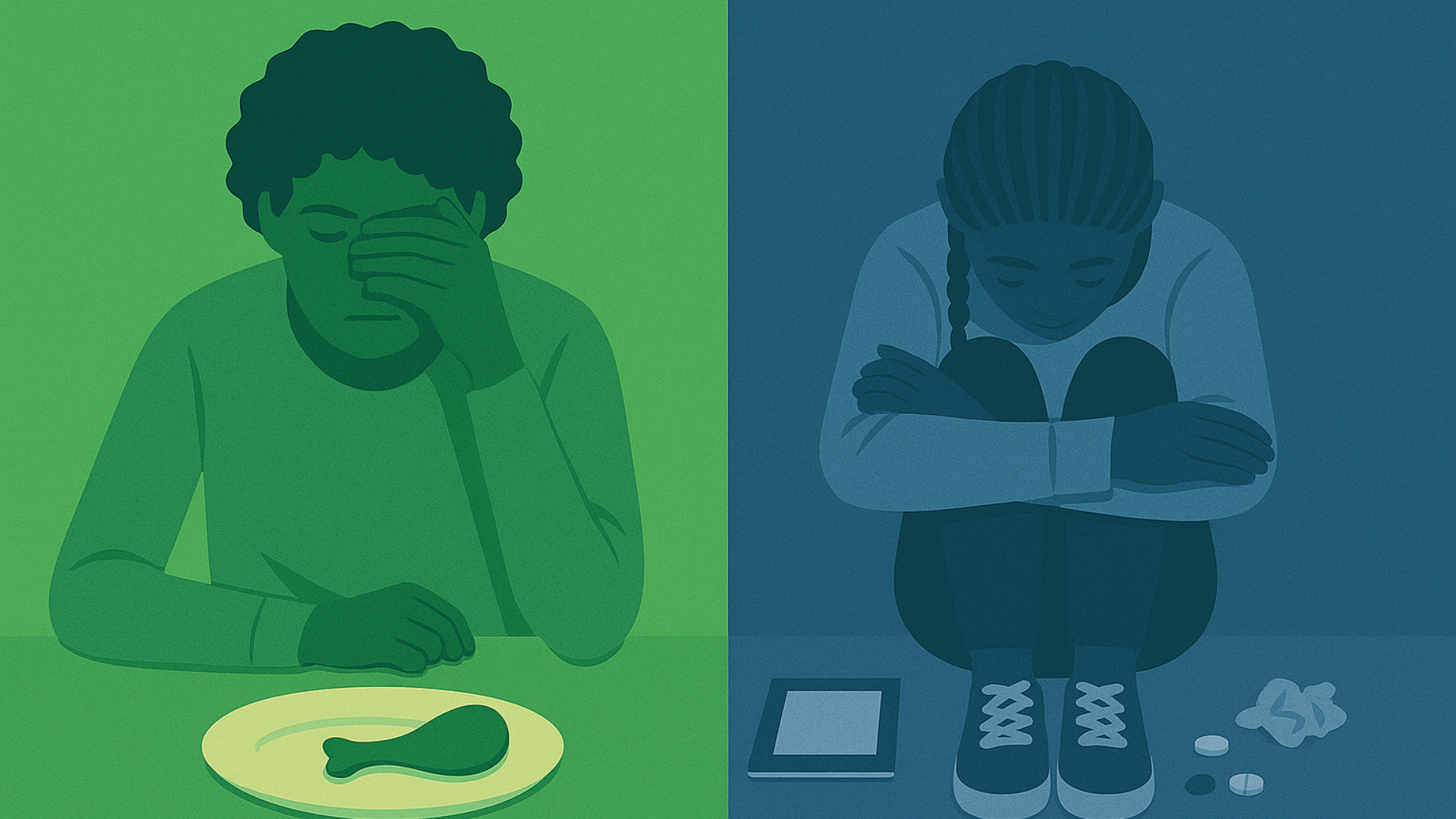The Role of Meal Support in Eating Disorder Treatment

By Thrive’s National Director of Nutrition Services Kailey Cunningham, M.S., RDN, LD
Meal support within eating disorder treatment is a clinician-guided intervention intended to help individuals overcome harmful food judgments and renourish their bodies by exposing them to eating experiences. Meal support encourages intuitive eating and mindful eating , while also helping diminish disordered eating behaviors . While an integral element of all of Thrive’s eating disorder treatment programs , Thrive’s Sacramento location recently unveiled extended meal support within its intensive outpatient program + (IOP+) for adults.
THE PURPOSE OF MEAL SUPPORT IN EATING DISORDER TREATMENT
Meal support in eating disorder treatment is primarily focused on helping patients establish adequate and consistent food intake, while also including a variety of foods from different food groups in their diets. Because eating disorder rules and rituals tend to include restrictive behaviors and narrowing of acceptable kinds of foods, eating enough and expanding variety are both key parts of recovery.
THE STABILIZING BENEFITS OF MEAL SUPPORT
Eating disorder behaviors wreak havoc on one’s overall nutrient status and can lead to vitamin and mineral deficiencies that negatively impact a person’s overall metabolism. This means the body doesn’t have the proper building blocks nor the energy that it requires to carry out the chemical reactions necessary to support normal body functions. This imbalance is the root cause of the myriad of physiological and some psychological symptoms many people with eating disorders experience.
Because cognitive functioning is significantly compromised by insufficient caloric intake, patients can’t fully participate in therapy of any kind if their brain isn’t adequately nourished. In other words, if a patient is not properly fed, they’re not able to participate in deep or meaningful therapy due to the biological impact of inadequate energy intake on brain function. Composed of matter that is 60% fat and fueled by carbohydrates, the brain suffers immensely when the body isn’t receiving enough of either of these macronutrients or enough food in general.
Further, when we eat a limited variety of foods, we likely get too much of some nutrients and not enough of others, which is the most significant nutritional drawback of a monotonous diet. The primary objective of meal support is to help patients provide their bodies with the fuel and nutrients needed to heal and, in the process, improve their overall relationship with food. Because eating disorders create many barriers to achieving this, meal support can assist by helping patients build skills to push back against their eating disorders while receiving direct and individualized support and accountability to help them do so.
HOW MEAL SUPPORT HELPS HEAL INDIVIDUALS’ RELATIONSHIPS WITH FOOD
Some of the most important work patients do in treatment happens at the table. Eating disorders tend to show up more directly during eating experiences. A person’s eating disorder voice generally becomes louder, while at the same time, specific food judgments , body image thoughts, and other anxieties surface.
This is an ideal opportunity for supported meals, where treatment teams can guide patients in directly challenging their eating disorder thinking by doing the opposite of what the eating disorder voice tells them to do. T hese clinician-guided meals help patients replace the maladaptive coping mechanisms of their eating disorder behaviors with more helpful coping tools such as therapeutic skills and mindfulness practices . Further, during supported meals, patients can gather evidence that encourages their abilities to fuel their bodies even though it may be very difficult. The goal of meal support is for patients to then be able to apply the skills and approaches they find helpful outside of treatment.
The healing effects of supported meals unfold throughout the recovery journey, sometimes beginning with the patient solely focusing on completing adequate meals and snacks much like checking a task off a to-do list, then progressing to the development of mindfulness practices including non-judgmental awareness and a stronger connection with hunger and fullness cues.
While our body’s own feedback is the only truly reliable guide for how to best fuel ourselves, that feedback cannot be fully trusted in the early stages of the treatment process. By establishing the foundation of consistent and adequate intake and challenging eating disorder thoughts, judgments, and urges, patients are able to reap the benefits of connecting with their authentic food preferences over time. This connection makes space for the practice of intuitive eating , our ultimate goal for every client.
THE ROLES OF TREATMENT PROFESSIONALS IN SUPPORTED MEALS
Therapeutic meals can be led by a variety of professionals. Therapists, registered dietitians/registered dietitian nutritionists (RD/RDNs), and trained support staff can each lead and co-lead meals. Ideally, meals are guided by at least two support staff and by a variety of eating disorder treatment professionals allowing each specialist to bring their unique skill set to the table.
Therapists are able to help patients utilize a variety of coping skills to navigate challenges they may face during meal times. These skills range from grounding and de-escalation to anxiety and stress management skills. Therapists incorporate a variety of evidence-based treatment modalities including acceptance and commitment therapy (ACT), dialectical behavioral therapy (DBT), and cognitive behavioral therapy (CBT). Trained support staff can also encourage the use of healthy coping skills while providing general support and accountability for meal completion. Additionally, therapists and support staff tend to be especially adept at interacting with patients and utilizing distraction techniques such as general conversation, playing games at the table, and other creative and engaging approaches.
RD/RDNs who are trained in treating eating disorders are uniquely qualified to provide support during meals. RD/RDNs help patients lean into what is true about food and learn to trust their bodies by challenging judgments that often originate from misinformation. RDs/RDNs can help patients debunk food biases and misconceptions about their bodies’ fuel needs by offering “fact-checking statements” about why they require a variety of foods and must be fed enough. For example, at a meal where a patient is struggling with consuming the necessary dietary fats their body requires, an RD/RDN may offer the fact-checking statement, “You actually need dietary fats to absorb all fat-soluble vitamins, which include vitamins D, E, K, and A. If your body doesn’t get enough fat, it also doesn’t get the vitamins it needs.” Or, if a patient is struggling with carbohydrates, an RD/RDN may provide a fact, such as, “Your body’s main source of energy is carbs. Every cell in your body uses carbs.”
Common misconceptions about these roles are that therapists can’t provide any information about food and RD/RDNs can’t recommend any therapeutic techniques. In reality, as each member of the support staff gains training and experience, they can cross over in the ways they offer support while still “staying in the lane” of their individual scope of practice. For instance, a therapist can offer nutrition fact-checking statements such as, “Your brain runs on carbohydrates” or “All foods fit.” Similarly, a dietitian can coach patients in the use of a variety of therapeutic interventions. For example, if a patient is beginning to feel overwhelmed, an RD/RDN can lead them through a grounding exercise.
WHAT TO EXPECT DURING SUPPORTED MEALS
In a typical programming meal, patients are supported in eating an appropriate amount and variety of food while focusing on their individual goals. Goals can vary from completing the meal to practicing mindfulness to challenging a specific eating disorder thought or behavior. Patients are then asked to identify how they specifically plan to meet this goal and what staff can do to help. Meals are ideally led by at least two treatment team members to ensure patients are able to receive one-on-one support when needed and to add to the professional voices and clinical approaches utilized at each meal.
Patients receive guidance regarding the amount of food their body needs as recommended by their individual RD/RDN. They practice with meals that they bring from home, meals prepared by staff, order-in or take-out meals, and meal outings. A key part of the meal is the check-in led by staff where each patient is asked to identify their goal or intention for the meal as well as to check in with their hunger and fullness sensations.
An adequate amount of food is plated by staff or the patient depending on their needs. When meals are provided by Thrive, patients are all expected to eat the same food or type of food to both practice flexibility and increase their exposure to variety.
For meals brought from home, patients are given guidelines and are encouraged to challenge their eating disorder with the types of foods they choose to bring. Sometimes meals brought from home entail a group theme or prompt for the meal. For example, all patients may be asked to bring fast food or to bring an Italian-style dish or dessert with their meal. This provides an opportunity for patients to expose themselves to variety and practice eating potentially feared or avoided foods with the support of both staff and the comradery of one another.
After the food is plated, patients and staff sit at the table together. The meal typically begins with some light conversation and time to allow each patient the opportunity to work toward their stated goal. Staff then checks in with the table as a whole or with individual patients regarding their goals, how things are going, and how staff can help support any struggles that may arise.
During meals, patients are expected to remain at the table together and are not allowed to use the restroom for at least thirty minutes afterward without supervision. Both of these measures are intended to reduce the opportunity for engagement in eating disorder behavior by decreasing access to opportunities and increasing accountability.
Some meals are more challenging and therefore require much more intensive therapeutic coaching and intervention while others allow an opportunity to practice eating in a social setting while engaging with others. Eating disorders tend to be very isolating illnesses. Therefore, it can be therapeutic to simply be at the table eating together. Generally, thirty minutes are allotted for meals beginning when everyone is seated.
While the overarching goal of every therapeutic eating experience is fueling the body with food, sometimes this is not possible due to the intensity of the eating disorder or gastrointestinal discomfort. If a patient is not able to nourish themselves despite support, they are provided with a proper amount of nutrition supplement drink to give their body necessary energy and nutrients. If a patient needs to supplement multiple times, their treatment level of care is reevaluated to make sure they are receiving the right level and kind of support they need to beat their eating disorder. Ongoing supplementation likely indicates the gastrointestinal issues are too complex or the eating disorder is too strong to be fought with the current level of support indicating the need for a step up in care. This approach is not at all meant to be punitive and instead is in place to ensure each client is receiving the proper support they need to recover.
At the end of the meal, staff lead everyone as they check out together. The check-out asks patients to each reflect on their goal and may ask them to specifically identify how they feel it went, what was helpful or not helpful including support from staff or peers, ways they can apply the experience to eating outside of treatment, specific skills they may have used, and their hunger and fullness cues.
Virtual meal support can provide the same general structure, just adjusted for telehealth. In these meals, patients are asked to plate an adequate amount of food on their own or with the help of a support person such as a family member or close friend. This is then verified by the staff leading the meal. Patients are asked to set up their cameras in such a way that staff can see their entire plate for the duration of the meal and can clearly see the patient and their surroundings. This is intended to reduce the opportunity for eating disorder behavior. Otherwise, the meal is led much like an in-person meal with a check-in, coaching from staff, and a check-out to close.
EXTENDED MEAL SUPPORT IN THRIVE SACRAMENTO’S IOP+
At our Thrive’s Sacramento location, we have recently begun offering additional meal support in our eating disorder IOP+ . Since this location began offering eating disorder treatment for adults in August 2021, we have recognized a need to incorporate more meal support into our adult programming in order to help those who require additional assistance in achieving their goals of adequate and consistent eating.
Monday through Thursday, dinner meals are supported in person for all IOP+ patients with additional virtual support offered during breakfast or morning snacks and lunch for those who would benefit from it. An added advantage of this structure is the opportunity for patients to practice eating in their “real-life” environments with accountability. Completing meals and challenging their eating disorders in their own homes or commonplaces allows patients to feel more comfortable fueling themselves in these same spaces outside of treatment time.
Learn more about Thrive Sacramento’s IOP+ and reach out to seek support.
About the Author
Thrive’s National Director of Nutrition Services Kailey Cunningham, M.S., RDN, CD
Kailey Cunningham, M.S., RDN, LD, is a registered dietitian nutritionist who obtained a master’s of dietetics degree from the University of Kentucky after completing both her undergraduate studies in dietetics and accredited dietetic internship at the same university.
She has been a registered dietitian nutritionist since February of 2013 and has been working in the eating disorder field since 2015. Kailey has experience treating clients at many levels of care, from partial hospitalization programming to outpatient, with a variety of diagnoses including anorexia nervosa, bulimia nervosa, binge eating disorder, ARFID and OSFED.
She began working at The Emily Program in Lacey, Washington for three years where she acted as the full-time programming dietitian. While in this position, she worked directly with a lead therapist to develop an adolescent treatment track implementing elements of Family-Based Treatment (FBT) and gaining invaluable experience working with adolescents and their parents. She then worked at Center for Discovery in Tacoma, Washington while building her nutrition counseling private practice. She began her successful practice in April of 2018 and moved it with her from Olympia, Washington to Rocklin, California in October 2020. Kailey joined Thrive Wellness Sacramento as a registered dietitian supervisor, providing support for adult and adolescent clients in intensive outpatient and outpatient levels of care. She now serves as the national director of nutrition services for Thrive Wellness overall.
Kailey’s primary motivator and true passion is supporting others on their journey to a more peaceful and balanced relationship with food and their bodies. Through individualized nutrition counseling and education, she helps those struggling with eating disorder behaviors, body image issues, food aversion and health anxieties find what is right for them while leaving diet culture behind.
The post The Role of Meal Support in Eating Disorder Treatment first appeared on Thrive Wellness.








